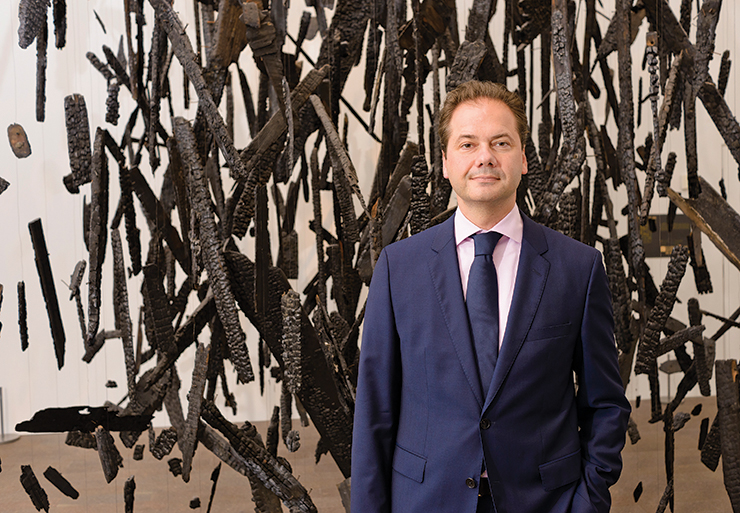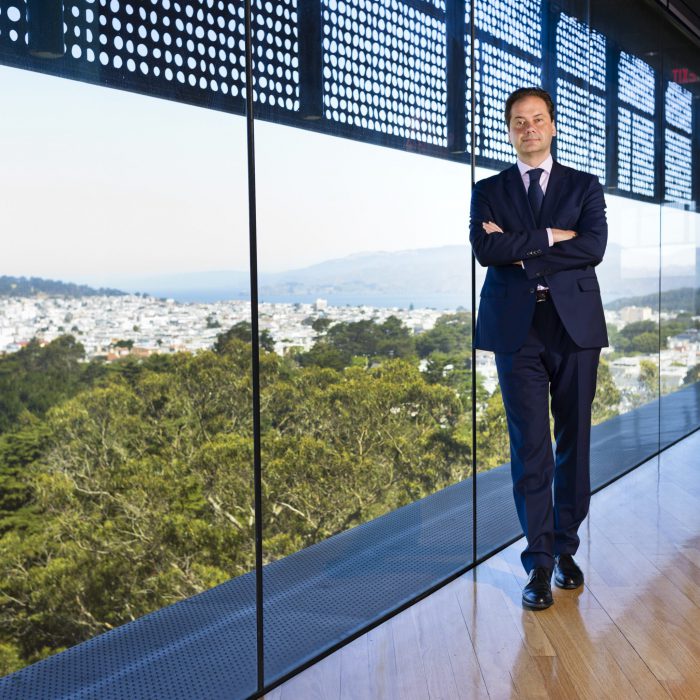
Max Hollein, the new director of San Francisco’s de Young and Legion of Honor museums, has terrific timing. For the past year, these “Fine Arts Museums of San Francisco” (FAMSF), as they are called, have been rocked by leadership problems, resulting from the transgressions of their CEO and board president Diane “Dede” Wilsey. Thankfully, Hollein is well qualified to untangle these issues, having run three of Germany’s most important museums, where he oversaw more than 300 exhibitions and innovated new forms of individual and corporate sponsorship.
“In Frankfurt, Max Hollein is perceived to be a genius,” says Tina Mendelsohn, an arts journalist who presents Kulturzeit, a German primetime cultural news program. “He has puppy charm, but is super savvy. He gets away with everything and gets along with everybody. We were shocked and dismayed when he left.”
In Europe, Hollein is the art-world equivalent of royalty. The son of avant-garde architect Hans Hollein, he grew up in Vienna surrounded by famous artists, designers, theater directors and intellectuals of all kinds. “At the dinner table, my father and his friends had strong debates. They were constantly yelling at each other,” says Hollein. Some of the museum director’s earliest childhood memories involve houseguests. Joseph Beuys, he recalls, “had a certain aura because he kept his hat on,” while Buckminster Fuller astonished the family by power napping. “He would lie down on my mother’s bed for 10 minutes, and then surprise us by jumping up refreshed.” Andy Warhol spoke few words and entertained the young Max by signing his name over and over again.
“My revolt against my parents was to develop a keen understanding of business,” says Hollein, whose father was often in financial trouble. Hollein pursued simultaneous degrees in art history and business administration in Vienna. “My parents would have loved me to be an artist. They were flabbergasted when I took an interest in the stock market,” he explains as he raps his fingers on a copy of Bilanz, a German business magazine for which he writes a monthly column.
Hollein usually opts for a suit and tie, but on this occasion, he sports a black sweater over a white pinstriped shirt. He sits at a large wooden table in the middle of his new office in Golden Gate Park, and seems older than his 47 years. However, his formality, which a German friend assures me is typically Austrian, eventually gives way to emphatic warmth and gentle amusement.

To the benefit of San Franciscans, Hollein already has American work experience. In the early ’90s, he interrupted his studies to do a three-month internship at the Guggenheim in New York, where he worked for then deputy director Michael Govan and chief curator Lisa Dennison. “If you worked for Michael and Lisa, even as an intern, you were part of the inner circle,” says Hollein. “I was impressed by the way they saw the museum in the middle of society, taking a stance and making an impact. It gave me a whole new idea about what a museum could be.”
After completing his degrees, Hollein returned to the Guggenheim, eventually becoming the right-hand man of Thomas Krens, the museum’s swashbuckling director, who became another “fairly towering father figure.” It was there that Hollein learned how to put out fires. “I’m not saying it was chaos,” he explains. “Tom had an extremely challenging vision for the institution. You could call it an artistic attitude.” After five years of dedication to Krens and his causes, and some significant side projects, such as commissioning the U.S. Pavilion at Venice’s Architecture Biennale, Hollein decided it was time to make a change.
In 2001, he traveled to Frankfurt to become the director of the Schirn Kunsthalle, a large exhibition space without a collection. There, he oversaw shows that balanced scholarship with popular appeal and increased attendance by 300 percent. It was through one of these thoughtful blockbusters, “Women Impressionists,” that Hollein first met Wilsey, who loaned works by Mary Cassatt, Berthe Morisot and Eva Gonzalès from her personal collection. Five years later, Hollein was promoted to oversee the two other museums linked with the Schirn: the Liebieghaus, a sculpture collection with works that reach back to Ancient Egypt, and the Städel, the oldest, most prestigious private museum in Germany.

Managing such a broad range of cultural forms came naturally to Hollein, who has always had eclectic tastes. During his teenage years, he obsessed over hardcore punk bands like Black Flag and the Dead Kennedys, and his two favorite artists were the flamboyant decadent modernist Francis Bacon, the flamboyant decadent modernist, and Petrus Christus, the restrained Renaissance altarpiece painter. As the director of the Städel, Hollein initiated and completed a €52 million expansion, increasing gallery space by 70 percent. He also strengthened the collection and raised private funds to increase the endowment by 50 percent.
As a sign of his ambition, Hollein also oversaw what was then the largest show of Jeff Koons’ work. Accommodating artists is “a strenuous process where you always have to excel,” says Hollein, and Koons was no exception. “Jeff is a fantastic artist. Every decision can cost you half a million,” he adds with a chuckle. “My job is to be the one who is calm and gets things done.” Koons, a self-declared perfectionist, was grateful. “Max’s ego is not prominent,” explains the artist. “You never meet Max Hollein and his ego. You meet a smart, supportive person who enables others.”

After 15 years in Frankfurt, Hollein was ready for a new challenge. He says he opted for the FAMSF job over a major European role because “now is the right time to be in San Francisco.” He sees the “momentum of the city” as a great opportunity for its cultural institutions and “almost a case study for the future.” Moreover, he thinks the Fine Arts Museums offer a clear chance for someone to “make a difference.”
Indeed, the de Young has strong attendance at its exhibitions, but its collection is arguably incoherent and its cultural mission unclear. Meanwhile, the Legion of Honor enjoys a beautiful building in a gorgeous location, but a dreary program in dire need of rejuvenation. Hollein is interested in “sharpening and reshaping” FAMSF’s relationship to contemporaneity, which will no doubt lead to “a different way of programming contemporary art than SFMOMA.”
To do this, Hollein needs to build a “very confident institution.” Although he never swerves from declaring his respect for Wilsey and his admiration of her generosity, he no doubt needs to bring some discipline to his board. When pressed, he only admits, “Major museums in serious cities always need to consider broadening their base of support.” After a history with larger-than-life father figures, Hollein is faced with an extraordinary matriarch. “Max is incredibly bright, cultured, mature and capable,” says Govan, now the director of the Los Angeles County Museum of Art. “He has experience that goes beyond that of most American museum directors. I am excited for California.”
Photo by Gregory Bertolini and Richard Barnes. Courtesy of Fine Arts Museums of San Francisco.



